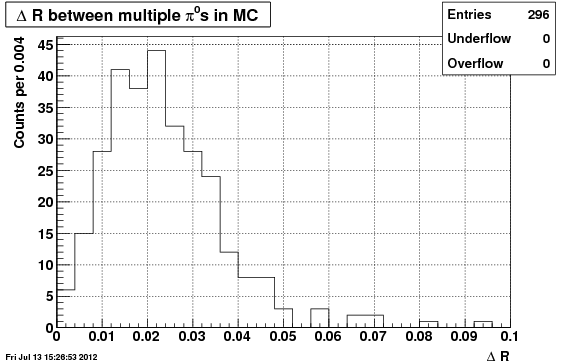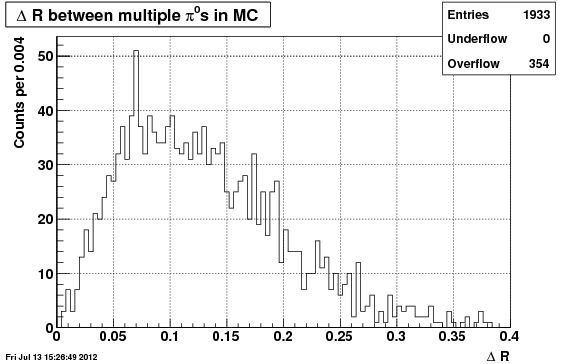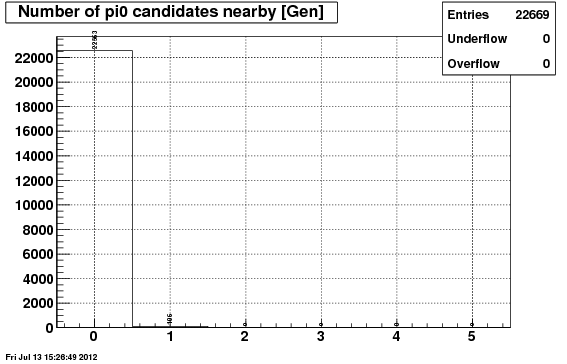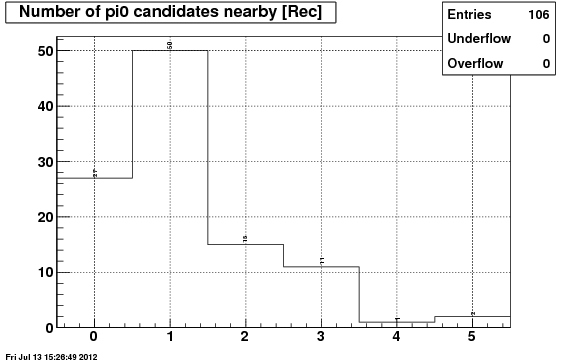Pi0 Nearness Cut
In the blog describing the TSIU clustering algorithm, a "cut" or procedure was introduced which checks amoung the pi0 candidates to see if any are within Delta R < 0.04. If so, the involved photons are resummed to make a new, merged pi0 candidate. The question arises how much this biases the sample, i.e. with what frequency is this merging true pi0s that we should have counted as seperate.
Delta R Distributions
Following is a distribution of the Delta R distance between reconstructed pi0 candidates, for events with multiple pi0s, only comparing pi0 candidates with pT > 4 GeV. The data set is pi0_set1_run1, which is a 10 GeV pi0 gun directed at phi = 0, eta = 1.5. False cluster splitting is more prevelant at higher pT (though less obvious since the low mass peak merges with the real pi0 peak), and so just the higher pT run is shown. Note, no events really have more than one generated pi0 per event, and so the multiple pi0 candidates are due to false cluster splitting. The algorithm used is TSIU, though the patterns are generally the same for the various algorithms.

Next, we'll make a comparison using Pythia QCD background data, the highest partonic pT bin, and compare the Delta R between generated pi0s, again looking at only pi0s with pT > 4 GeV.

Note the change in scales between the two plots. The Delta R due to false cluster splitting is peaked near 0.02, and extends only up to around 0.05, while the true Delta R between real pi0s rises fairly linearly from 0 to 0.05, has a broad peak from 0.05 to 0.12, and then tapers off until around 0.3. The distributions are distinct enough to merit placing a cut. The value of 0.04 is chosen, mainly based on historical reasons, though it does seem a good value based on the above plots, i.e. cuts most of the background without cutting much signal.
Counts of Pi0s near Pi0s
Again using the Pythia data, we can look at how many pT > 4 pi0s occur within Delta R < 0.04 of another pT > 4 pi0.

Only 106 out of 22669 pT > 4 GeV pi0s had another pT > 4 GeV pi0 closeby. Amoung those 106 generated pi0s, one can then count how many reconstructed pi0s with pT > 4 also fall within the Delta R > 0.04 window.

Summing the cases with more than one reconstructed pi0 in the window, one arrives at 29 generated pi0s that would be lost due to introducing the proposed cut/procedure. Note though, of those 29, in all cases there were two generated pi0s, though the half of them are reconstructed with more than two in the Delta R window. A potential loss of 29 out of 22669, or 0.1%. This is considered a negligible effect.
- sgliske's blog
- Login or register to post comments
